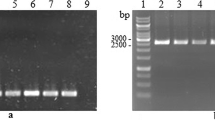Abstract
A method for the formation and regeneration of protoplasts of several strains of the chestnut blight fungus,Cryphonectria parasitica, is presented. The procedure utillizes cellophane membranes for growth and employs centrifugation for separation of protoplasts from hyphal fragments. Yields averaged 8.04×106 protoplasts per membrane. Regeneration frequencies were 40–50% with a soft-agar overlay. These protoplasts are suitable for use in experiments designed to determine the role of dsRNA in hypovirulence ofC. parasitica.
Similar content being viewed by others
Literature Cited
Anagnostakis SL (1984) Nuclear gene mutations inEndothia (Cryphonectria) parasitica that affect morphology and virulence. Phytopathology 74:561–565
Barrett V, Lemke PA, Dixon RK (1989) Protoplast formation from selected species of ectomycorrhizal fungi. Appl Microbiol Biotechnol 30:381–387
Dales RBG, Croft JH (1977) Protoplast fusion and the isolation of heterokaryons and diploids from vegetatively incompatible strains ofAspergillus nidulans. FEMS Microbiol Lett 1:201–204.
Day PR, Dodds JA, Elliston JE, Jaynes RA, Anagnostakis SL (1977) Double-stranded RNA inEndothia parasitica. Phytopathology 67:1393–1396
de Vries OMH, Wessels JGH (1972) Release of protoplasts fromSchizophyllum commune by a lytic enzyme preparation fromTrichoderma viride. J Gen Microbiol 73:13–22
Dodds JA (1980) Revised estimates of the molecular weights of dsRNA segments in hypovirulent strains ofEndothia parasitica. Phytopathology 70:1217–1220
Elliston JE (1985) Characteristics of dsRNA-free and dsRNA-containing strains ofEndothia parasitica in relation to hypovirulence. Phytopathology 75:151–158
Fincham JRS (1989) Transformation in fungi. Microbiol Rev 53:148–170 53:148–170
Gaugy D, Fevre M (1985) Regeneration and reversion of protoplasts from different species ofPenicillium. Microbios 44:285–293
Grente J, Berthelay-Sauret S (1978) Biological control of chestnut blight in France. In: MacDonald W, Chech F, Luchok J, Smith C (eds) Proceedings of the American Chestnut Symposium. W. Va Univ and US Forest Service, pp 30–34
Hwang SC, Ko WH, Aragaki M (1975) A simplified method for sporangial production byPhytophthora cinnamomi. Mycologia 67:1233–1234
Jaynes RA, Elliston JE (1982) Hypovirulent isolates ofEndothia parasitica associated with large American chestnut trees. Plant Dis 66:769–772
Kitamoto Y, Mori N, Yamamoto M, Ohiwa T, Ichikawa Y (1988) A simple method for protoplast formation and improvement of protoplast regeneration from various fungi using an enzyme fromTrichoderma harzianum. Appl Microbiol Biotechnol 28:445–450
Kunkel W, Groth I, Jacob HE, Risch S, Harnisch M, May R, Berg H, Katenkamp U (1987) Electrofusion of protoplasts ofPenicillium chrysogenum. Stud Biophys 119:35–36
Layton AC, Kuhn DN (1988) Heterokaryon formation by protoplast fusion of drug-resistant mutants inPhytophthora megasperma f. sp.glycinea. Exp Mycol 12:180–194
Puhalla JE, Anagnostakis SL (1971) Genetics and nutritional requirements ofEndothia parasitica. Phytopathology 61:169–173
Sonnenberg ASM, Wessels JGH (1987) Heterokaryon formation in the basidiomyceteSchizophyllum commune by electrofusion of protoplasts. Theor Appl Genet 74:654–658
Van Alfen NK, Jaynes RA, Anagnostakis SL, Day PR (1975) Chestnut blight: biological control by transmissible hypovirulence inEndothia parasitica. Science 189:890–891
Yamada O, Magae Y, Kashiwagi Y, Kakimoto Y, Sasaki T (1983) Preparation and regeneration of mycelial protoplasts ofCollybia velutipes andPleurotus ostreatus. Eur J Appl Microbiol Biotechnol 17:298–300
Author information
Authors and Affiliations
Rights and permissions
About this article
Cite this article
Jang, JC., McElreath, S.D. & Tainter, F.H. A membrane technique for producing protoplasts ofCryphonectria parasitica . Current Microbiology 26, 113–116 (1993). https://doi.org/10.1007/BF01577346
Issue Date:
DOI: https://doi.org/10.1007/BF01577346




